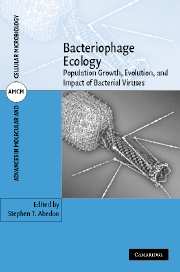Book contents
- Frontmatter
- Contents
- About the cover
- List of contributors
- Foreword by Bruce R. Levin
- Preface
- 1 Phages, ecology, evolution
- Part I Phage ecology
- Part II Phage evolutionary biology
- 6 Phage evolutionary biology
- 7 Phage evolution
- 8 Evolutionary ecology of multiple phage adsorption and infection
- 9 Patterns in phage experimental adaptation
- Part III Phage ecology in environments
- Part IV Modeling phage ecology
- Index
- Plate section
7 - Phage evolution
from Part II - Phage evolutionary biology
Published online by Cambridge University Press: 29 September 2009
- Frontmatter
- Contents
- About the cover
- List of contributors
- Foreword by Bruce R. Levin
- Preface
- 1 Phages, ecology, evolution
- Part I Phage ecology
- Part II Phage evolutionary biology
- 6 Phage evolutionary biology
- 7 Phage evolution
- 8 Evolutionary ecology of multiple phage adsorption and infection
- 9 Patterns in phage experimental adaptation
- Part III Phage ecology in environments
- Part IV Modeling phage ecology
- Index
- Plate section
Summary
INTRODUCTION
Bacteriophages have a long history as objects of biological study. They were discovered about 90 years ago and have engaged biologists ever since, initially for their potential in combating human disease through phage therapy. Later, phages served as arguably the most important model systems in the development of the discipline of molecular biology and the associated explosion of knowledge about the detailed workings of genes and cells. Yet it is only in very recent years that the study of phage evolution has attracted the attention of more than a handful of individuals. The primary reasons for the current increased interest in phage evolution, I would suggest, are two: discovery, over the past 20 years, of astonishingly high phage population numbers in the natural environment, and improved, low-cost methods of phage genotypic analysis, especially DNA sequencing. In this chapter I discuss the abundance and diversity of the global phage population, with an emphasis on what we are learning from comparative genomic studies about the mechanisms by which it has evolved to its current state.
Chapter 6 provides an introduction to basic evolutionary mechanisms of phage evolution. See Hendrix (2003), Casjens (2005), and Brüssow and Desiere (2006) for additional reviews of phage evolution from the perspective of genomic studies.
Information
- Type
- Chapter
- Information
- Bacteriophage EcologyPopulation Growth, Evolution, and Impact of Bacterial Viruses, pp. 177 - 194Publisher: Cambridge University PressPrint publication year: 2008
Accessibility standard: Unknown
Why this information is here
This section outlines the accessibility features of this content - including support for screen readers, full keyboard navigation and high-contrast display options. This may not be relevant for you.Accessibility Information
- 11
- Cited by
